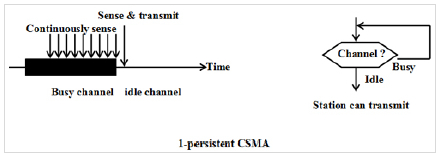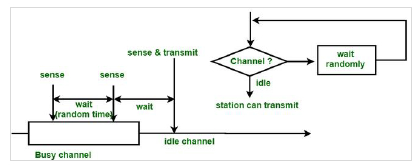
 Data Structure
Data Structure Networking
Networking RDBMS
RDBMS Operating System
Operating System Java
Java MS Excel
MS Excel iOS
iOS HTML
HTML CSS
CSS Android
Android Python
Python C Programming
C Programming C++
C++ C#
C# MongoDB
MongoDB MySQL
MySQL Javascript
Javascript PHP
PHP
- Selected Reading
- UPSC IAS Exams Notes
- Developer's Best Practices
- Questions and Answers
- Effective Resume Writing
- HR Interview Questions
- Computer Glossary
- Who is Who
What are the differences between 1-Persistent and Non-Persistent CSMA?
The three types of Carrier Sense Multiple Access (CSMA) Protocols are as follows −
- 1-persistent CSMA
- Non- Persistent CSMA
- p-persistent CSMA
1-persistent CSMA
In this method, to transmit data the station wants to continuously sense the channel to check whether the channel is busy or idle.
Suppose, if the channel is busy, then the station will wait until it becomes idle. Whenever the station detects an idle-channel, then it transmits the frame with probability. Therefore this persistence is called 1-persistent CSMA.
The 1-persistent CSMA has the highest chance of collision because two or more stations identify a channel to be idle at the same time and transmit their frames.
Whenever the collision occurs, the stations will wait a random amount of time and start again. The structure of 1-persistent CSMA is as follows −

Drawback of 1-persistent
In this 1-persistence the propagation delay time is more.
For example − If station 1 begins its transmission, at the same time station 2 is also ready to send its data and senses the channel. If the station 1 signal has not still reached station 2, station 2 thought that the channel is idle and will begin its transmission. This will result in a collision.
Even though the propagation delay time is zero, the collision will occur. If two stations are ready in the middle of the third station's transmission, then both stations have to wait till the transmission of the first station ends and then both will begin their transmission exactly at the same time. This will also result in collision.
Non-Persistent CSMA
Non-persistent is called as a non-aggressive version of CSMA protocols which comes under the MAC (Medium Access Control) layer. Here the station which has the frames to send, that station only senses the channel.
Suppose if it is an idle channel, then non-persistent frames will send frames immediately to that channel. So, here the channel seems to be busy, then it will wait for the random time and again sense the state of the station whether idle or busy.
In a non-persistent method, the station will not immediately sense the channel. The main advantage is it reduces the chances of collision. But the problem in on-persistence is that it reduces the efficiency of the network.
The advantage of non-persistent CSMA is that it reduces the chance of collision because the stations wait a random amount of time. The disadvantage is that it reduces the efficiency of the network because the channel remains idle when there are stations with frames to send.
Given below is the structure of Non-persistent CSMA −

Differences
The major differences between 1-persistent CSMA and non-persistent CSMA are as follows −
| 1-persistent CSMA | Non-persistent CSMA |
|---|---|
| Whenever the carrier sense channel is idle the 1-persistence send with probability 1 | The Non-persistence sends when the channel is idle. |
| The 1-persistent will continuously sense the channel for the frames transmission , it will not wait. | The Non-persistent waits for the random amount of time to check the carrier. |
| In 1-persistence the chance of collisions is more. | In non-persistent there is a less chances of collision when compared to 1-persistence |
| Delay low load is small in 1-persistent. | Delay low load is longer when compared to 1-persistent. |
| The 1-persistent utilization is above ALOHA. | The non-persistent utilization is above 1-persistent because all stations are not constantly checking the channel at the same time. |

